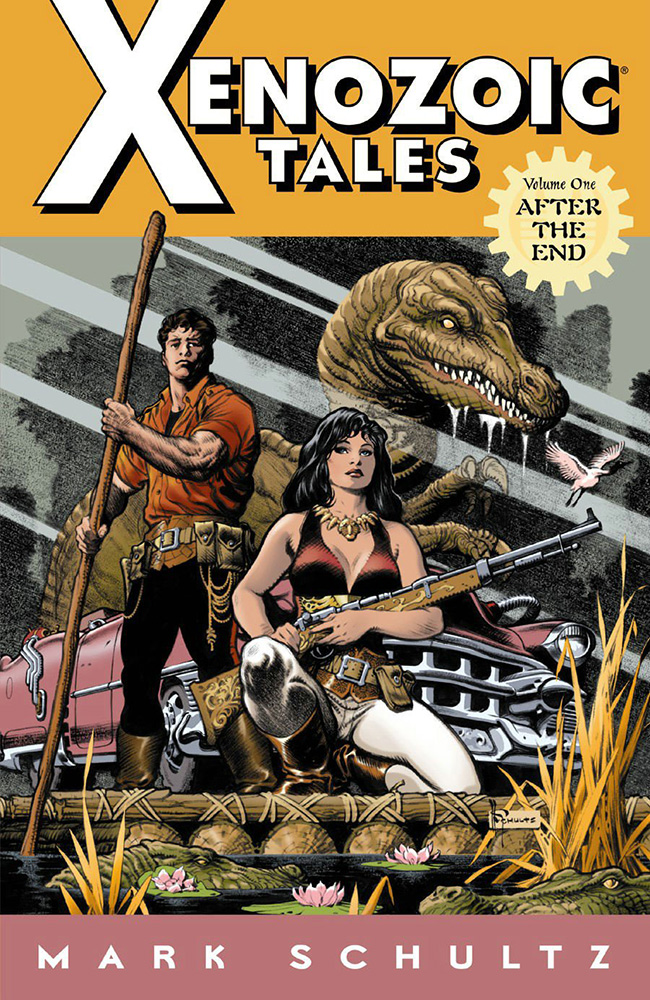Jurassic World had a hell of debut. Over half a billion dollars worldwide in less than a week is a pretty potent sign that we still love to see dinosaurs tear it up on screen. And while we already know that Owen Grady is going to keep tussling with ancient monsters for a few more films, I imagine that other studios are thinking about getting in on the dinosaur game, too.
Execs could dust off some old projects. A few years ago there was a lot of hullaballoo about Barry Sonnenfeld and Grant Morrison teaming up on the graphic novel/movie project Dinosaurs vs. Aliens. Not to be outdone, Warner Bros. announced they were considering a movie about dinosaurs attacking LA. Not to mention that there are numerous other dinosaur stories in comics and literature, from Greg Bear’s nostalgic Dinosaur Summer to the ludicrously gory Dinosaurs Attack! and the gonzo Dinosaurs For Hire. There’s really no shortage of prehistoric tales. But there’s one I want to see more than any other.
While suggesting a mash-up between Jurassic World and Mad Max: Fury Road might seem like a trite Hollywood ploy to blend two major moneymakers, the truth is that such a combination is the quickest way to describe a comic classic—Mark Schultz’s Xenozoic Tales. This is the dinosaur movie we need next.
Much like Fury Road, Xenozoic Tales is set well after humanity screwed everything up. Climate change and geologic upheaval at the end of the 20th century forced our species to shelter in underground bunkers for 600 years. When the scattered survivors emerged, though, they didn’t find a wasteland but a new world where dinosaurs and other forms of prehistoric life had reclaimed the land, sea, and sky.
Jack Tenrec stands at the intersection of the old and new worlds. Schultz’s protagonist, Tenrec is a hard-nosed mechanic who, when not fixing up old Cadillacs to make supply runs through deserts and swamps, tracks down dinosaur poachers and tries to prevent the local government from squeezing every resource from the land. He goes with his gut and is concerned above all else with maintaining a balance with nature. But he’s not much more than a grumpy mechanic without Hannah Dundee—a scientist and ambassador from a distant tribe who doesn’t buy into Jack’s spiritual views, but nevertheless wants to prevent humanity from causing another catastrophe.
There’s a greater, as-yet-unfinished story arc to the series, but even some of the smaller tales could provide plenty of room to explore this new cinematic territory. The early stories “Law of the Land” and “Rogue,” for example, pit Tenrec against poachers as he runs a convoy to a mining station being terrorized by a tyrannosaur. The two-part tale goes a long way to establishing the feel of the new world, Tenrec’s wilderness morality, and gives Dundee plenty of opportunities to challenge Tenrec’s self-appointed authority as nature’s watchdog. That’s only if someone wanted to start from a pre-existing story, though. Schultz’s Xenozoic world is certainly big enough for new adventures.
This is more than Cadillacs and Dinosaurs, as the offshoot animated show and video game dubbed the story. First off, now that we’re well past peak zombie, Xenozoic Tales could be a fresh way to explore some very real fears. As the series itself recognizes, we can see runaway climate change and other ecological catastrophes coming down the line yet we are doing precious little to stop disaster. Being knocked down a few notches on the food chain while dinosaurs reclaim the Earth could hold up a mirror to real world concerns the way the best science fiction does.
And, as a fossil fanatic, I have to admit that I’d love to see a new movie take on dinosaurs. The hybrid, scaly frogosaurs of Jurassic Park are canon for the series. They’re not going to change. If we’re going to get a new image of terrifyingly fluffy dinosaurs, it’s going to have to come from another venue. Xenozoic Tales could do that.
Most of the creatures in Schultz’s original story are familiar saurians given colloquial names—cutter (Allosaurus), mack (horned dinosaurs), wahonchuck (Stegosaurus), shivat (Tyrannosaurus). But, given that evolution is contingent and does not follow predetermined paths, artists could create new, speculative dinosaurs that riff on what paleontologists have found in the fossil record. For my money, I think artist Brian Engh’s speculative carnivores—created as a riposte to Jurassic World’s Indominus rex—offer some truly awesome possibilities for speculative, scientifically-sound dinosaurs.
Science doesn’t own dinosaurs. Neither does pop culture. The two competing forces have shaped dinosaurs at the outset, from the Victorian monsters of Crystal Palace Park to Jurassic World. Letting them loose in a fictional world where nature’s “reset” button has been firmly pressed by our own species would once again let them take up their celebrated role as creatures between science and scifi. If allowed cinematic de-extinction, Xenozoic Tales could let dinosaurs do what they do best.
Brian Switek is the author of My Beloved Brontosaurus (out in paperback from Scientific American/Farrar, Straus and Giroux) and Written in Stone. He also writes the National Geographic blog Laelaps.










